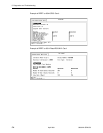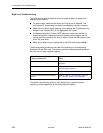
5. Diagnostics and Troubleshooting
5-6
April 2001 8000-A2-GB26-50
Ethernet Port
Failure
1. Check cable connections to the chassis.
– If cables are terminated properly, go to Step 2.
– If cables are not terminated properly, terminate them correctly.
2. Check cable connections to the hub or Ethernet switch.
– If cables are terminated properly, go to Step 3.
– If cables are not terminated properly, terminate them correctly.
3. Check the Activity/Status LED at the Ethernet hub
.
– If Activity/Status LED does not indicate a problem, go to Step 4.
– If Activity/Status LED indicates a problem, take appropriate
action.
4. Disconnect the Ethernet cable and replace it with a working cable
from a spare port on the hub.
– If the replacement cable works, the original is bad and should be
permanently replaced.
– If the replacement cable does not work, reconnect the original
cable and go to Step 5.
5. Move the DSL card and cable to another (spare) slot.
– If this solves the problem, the connector or interface panel
connections for the original slot are bad. Schedule maintenance
for the chassis and try to use the spare slot temporarily.
– If this does not solve the problem, the DSL card is probably bad
and should be replaced.
Link Down
Threshold
(A trap message
is sent if the
number of DSL
link down events
in 15 minutes
exceeds the
selected value.)
If the threshold is set low (1–4) and the link is currently down, then
there may be a local loop or Service Node problem. Check both.
– Verify that the Service Node is powered up, is connected to the
local loop, and has passed its selftest.
– Check the loop for continuity.
If the threshold is set low (1–4) and the link is currently up, then an
event had occurred to temporarily knock out the connection. Log
the event and continue normal operation.
If the threshold is set high (more than 4) and the link is currently
down, then check the Margin statistics over the past hour and day. If
the numbers are low, there may be a situation where the DSL
modems cannot train. This condition may be temporary or
permanent. However, if it persists, the loop may have to be
reengineered for better performance by performing one of the
following:
– Remove bridge taps.
– Change cable gauge on a cable section.
– Run new cable.
– Remove other noise-generating digital circuits from the cable
bundle.
If the threshold is set high (more than 4) and the link is currently up,
then there may be a loose connection in the loop plant, or the loop
is barely usable. Check the Margin. If the Margin is normal, there
may be a loose connection. If the Margin is low, try reducing the
speed of the DSL port.
Table 5-2. Major Alarms (2 of 3)
Alarm Action


















